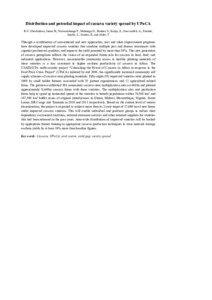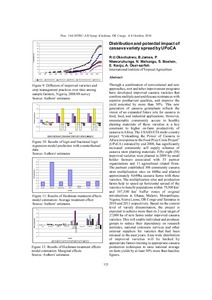| dc.contributor.author | Okechukwu, R.U. |
| dc.contributor.author | James, B. |
| dc.contributor.author | Ntawuruhunga, Pheneas |
| dc.contributor.author | Mahungu, N.M. |
| dc.contributor.author | Boahen, S. |
| dc.contributor.author | Kanju, E. |
| dc.contributor.author | Osei-Sarfoh, A. |
| dc.date.accessioned | 2019-12-04T11:07:57Z |
| dc.date.available | 2019-12-04T11:07:57Z |
| dc.date.issued | 2012-02 |
| dc.identifier.citation | Okechukwu, R.U., James, B., Ntawuruhunga, P., Mahungu, N., Boahen, S., Kanju, E. & Osei-sarfoh, A. (2012). Distribution and potential impact of cassava variety spread by UPoCA. In: Proceedings of the 11th triennial Symposium of the ISTRC-AB held at Memling Hotel: tropical roots and tuber crops and the challenges of globalization and climate changes, (pp. 325-331), 4-8 October, Kinshasa, Democratic Republic of Congo. |
| dc.identifier.uri | https://hdl.handle.net/20.500.12478/1665 |
| dc.description.abstract | Through a combination of conventional and new approaches, root and tuber improvement programs have developed improved cassava varieties that combine multiple pest and disease resistances with superior postharvest qualities, and improve the
yield potential by more than 50%. This new generation of cassava germplasm reflects the vision of an expanded future role for cassava in food, feed, and industrial applications. However, unsustainable community access to healthy planting materials of these varieties is a key constraint to higher on-farm productivity of cassava in Africa. The USAID/IITA multi-country project “Unleashing the Power of Cassava in Africa in response to the Food Price Crisis Project” (UPoCA) initiated by end 2008, has significantly increased community self supply schemes of cassava stem planting materials. Fifty-eight (58) improved varieties were planted in 2009 by small holder farmers associated with 55 partner organizations and 11 agricultural related firms. The partners established 306 community cassava stem multiplication sites on 448ha and planted approximately 9,649ha cassava farms with these varieties. The multiplication sites and production farms help to speed up horizontal spread of the varieties to benefit populations within 79,500 km2 and 107,500 km2 buffer zones of original introductions in Ghana, Malawi, Mozambique,
Nigeria, Sierra Leone, DR Congo and Tanzania in 2010 and 2011 respectively. Based on the current level of variety dissemination, the project is expected to achieve more than its 2-year target of 27,000 ha of new farms under improved cassava varieties. This will enable individual and producer groups to reduce their dependency on research institutes, national extension services and other external suppliers for varieties that had been released in the past years. Area-wide distribution
of improved varieties will be backed by appropriate farmer training in appropriate cassava production techniques to raise national average on-farm yields by at least 30% more than baseline figures. |
| dc.description.sponsorship | United States Agency for International Development |
| dc.format.extent | 325-331 |
| dc.language.iso | en |
| dc.publisher | International Society For Tropical Root Crops-Africa Branch |
| dc.subject | Cassava |
| dc.subject | Yield Gap |
| dc.subject | Disease Control Methods |
| dc.subject | Technology Transfer |
| dc.subject | Upoca |
| dc.subject | Seed System |
| dc.subject | Yield Gaps |
| dc.subject | Variety Spread |
| dc.title | Distribution and potential impact of cassava variety spread by UPoCA |
| dc.type | Conference Proceedings |
| dc.description.version | Peer Review |
| cg.contributor.crp | Roots, Tubers and Bananas |
| cg.contributor.affiliation | International Institute of Tropical Agriculture |
| cg.coverage.region | Africa |
| cg.coverage.region | Central Africa |
| cg.coverage.region | East Africa |
| cg.coverage.region | Southern Africa |
| cg.coverage.region | West Africa |
| cg.coverage.country | Congo, Dr |
| cg.coverage.country | Ghana |
| cg.coverage.country | Malawi |
| cg.coverage.country | Mozambique |
| cg.coverage.country | Nigeria |
| cg.coverage.country | Sierra Leone |
| cg.coverage.country | Tanzania |
| cg.authorship.types | CGIAR single centre |
| cg.iitasubject | Cassava |
| cg.iitasubject | Genetic Improvement |
| cg.iitasubject | Handling, Transport, Storage And Protection Of Agricultural Products |
| cg.iitasubject | Impact Assessment |
| cg.iitasubject | Post-Harvesting Technology |
| cg.howpublished | Formally Published |
| cg.publicationplace | Ibadan, Nigeria |
| cg.accessibilitystatus | Limited Access |
| local.dspaceid | 82824 |
| cg.targetaudience | Scientists |


